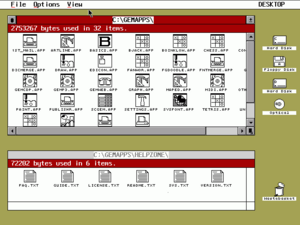Software:OpenGEM
 OpenGEM showing hard disk and CD-ROM icons (to the right) | |
| Repository | sourceforge |
|---|---|
| Operating system | DOS |
| Available in | English |
| Type | Windowing system |
| License | GNU General Public License |
OpenGEM is a non-multitasking 16-bit graphical user interface (GUI) for DOS. It is an extended distribution of FreeGEM that includes features of the original Digital Research GEM.
OpenGEM is intended to provide a simple to install and use GUI system and windowing framework for the FreeDOS operating system.
Caldera Thin Clients (later known as Lineo), who owned the source code to GEM through Caldera's purchase of the remaining Digital Research assets from Novell on 23 July 1996,[1] released the source to GEM under the terms of GNU General Public License (GPL) in April 1999.[2] OpenGEM was developed by Shane Martin Coughlan in collaboration with the FreeGEM Developer team, and is free software released under the terms of the GNU General Public License (GPL). OpenGEM versions 3 through 6 are hosted on SourceForge and on the FreeDOS website.
OpenGEM has not been actively developed since 2008 but is feature-complete as a basic GUI and includes a full SDK for future third party development or extension.
Compatibility
OpenGEM works with FreeDOS Beta 9 and above, DR DOS 5.0 and above, MS-DOS 3.3 and above, PC DOS 3.3 and above, REAL/32, and DOSBox 0.65. OpenGEM will function on Windows 95, Windows 98, Windows 98SE, Windows Me. It is not known to work with Windows NT, Windows 2000 and Windows XP or above.
See also
References
- ↑ "Caldera reopens 'settled' suit, buys DR DOS". IDG. 1996-07-29. https://www.computerworld.co.nz/article/519730/caldera_reopens_settled_suit_buys_dr_dos/.
- ↑ "Caldera releases GEM under the GPL". Deltasoft - GEM News. April 1999. http://www.deltasoft.com/news.htm. "Caldera Thin Clients, Inc. released the source code for GEM and ViewMAX under the GNU Public License in mid April, following years of speculation over GEM's future. Caldera bought the GEM sources from Novell along with the DR-DOS in 1996, at the time noting that they may develop GEM into a platform for mobile computers and thin clients. However, these plans were dropped, and GEM was instead released into the open-source community."
External links

